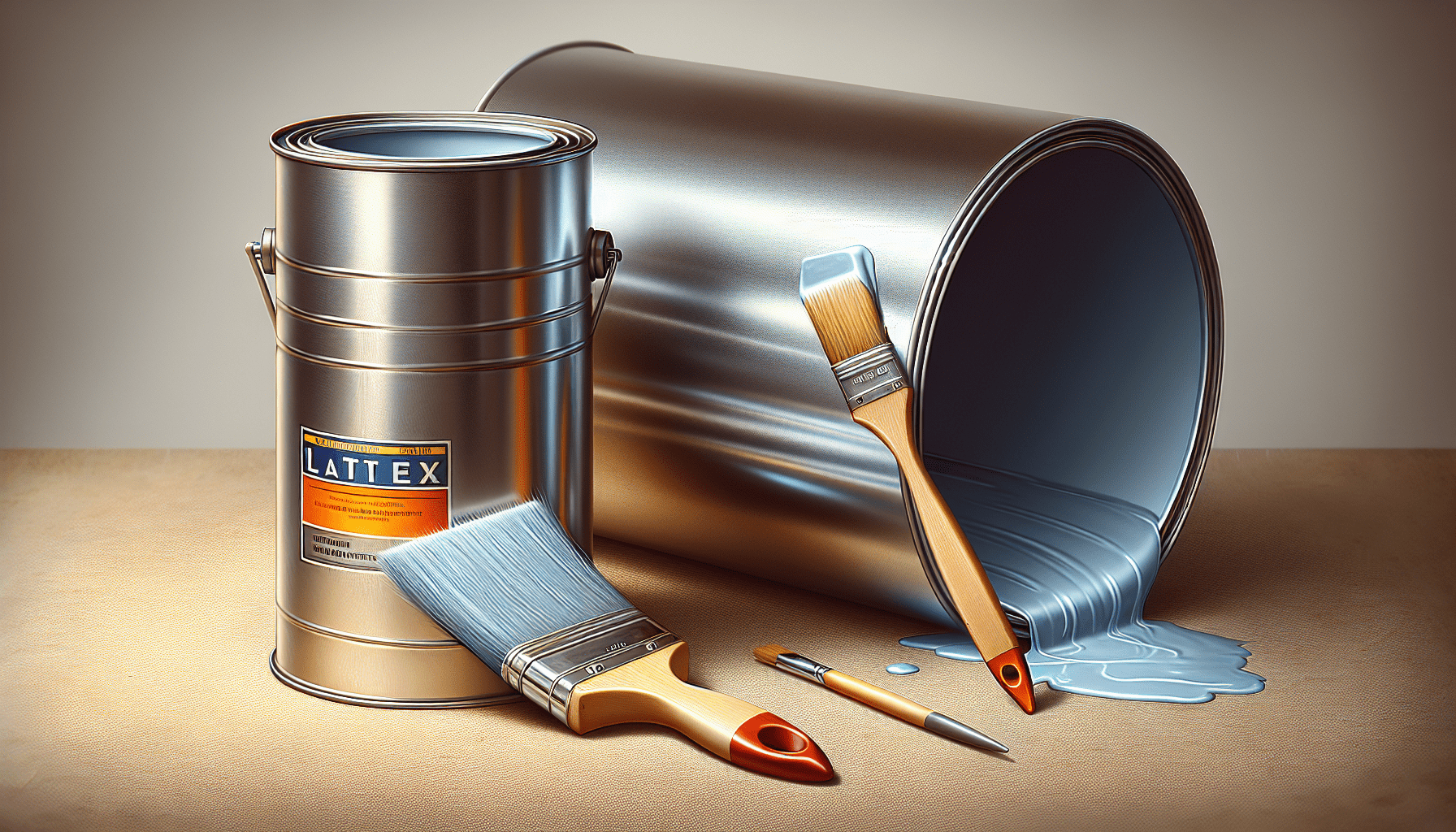Water based paint is a popular choice for both professional painters and DIY enthusiasts due to its ease of use, quick drying time, and low odor. However, there seems to be some confusion surrounding the term “latex” when it comes to water based paints. Many people wonder: Is water based paint latex? In this article, we will explore the relationship between water based paint and latex, clarifying any misconceptions and providing a clear understanding of the differences between the two.
Definition of Latex Paint
What is latex paint?
Latex paint, also known as water-based paint, is a type of paint that uses water as the main solvent. It is a popular choice for both interior and exterior applications due to its ease of use, durability, and environmental friendliness. Latex paint consists of pigments, binders, additives, and water, which give it its unique characteristics.
Composition of latex paint
Latex paint is composed of various components that work together to create a smooth, durable, and long-lasting finish. The main ingredients are pigments, which provide color; binders, which hold the pigment particles together and adhere them to the surface; additives, which enhance the performance and properties of the paint; and water, which acts as the solvent and carrier.
Water-Based Paints
Overview of water-based paints
Water-based paints are a category of paints that use water as the main solvent instead of organic solvents like oil or mineral spirits. They are known for their low odor, quick drying time, and ease of use. Water-based paints are widely used in both residential and commercial applications due to their versatility and environmental benefits.
Properties of water-based paints
Water-based paints have several properties that make them advantageous over other types of paints. They have low volatile organic compound (VOC) emissions, which means they release fewer harmful chemicals into the air. Water-based paints also have good color retention, are resistant to cracking and peeling, and offer excellent adhesion to various surfaces. Additionally, they can be easily cleaned up and dispose of with water, making them user-friendly and environmentally conscious.

Is Water-Based Paint Latex?
Clarifying the confusion
There is often confusion between water-based paint and latex paint, as both terms are used interchangeably. However, it is important to note that not all water-based paints are latex paints. Latex paint is a specific type of water-based paint that uses a latex binder or resin, which is made from synthetic polymers such as acrylic or vinyl. On the other hand, water-based paints can also include other types of binders, such as acrylic, alkyd, or epoxy.
Difference between latex and water-based paints
The main difference between latex paint and other types of water-based paints lies in the type of binder used. Latex paint specifically uses a latex binder, which provides excellent adhesion, flexibility, and durability. Other water-based paints may use different binders, which can result in variations in performance and properties. It is important to check the label or product specifications to determine if a water-based paint is latex or not.
Advantages of Water-Based Paints
Durability
Water-based paints, including latex paint, offer excellent durability. They are resistant to cracking, peeling, and color fading, ensuring a long-lasting finish on various surfaces. Latex paint, in particular, has exceptional adhesion properties, allowing it to adhere well to different materials, such as wood, drywall, and metal. This durability makes water-based paints an ideal choice for high-traffic areas or surfaces that require frequent cleaning.
Ease of application
Water-based paints are known for their ease of application. They have a smooth consistency, which makes them easy to spread and apply evenly on surfaces. Water-based paints also have a quick drying time, allowing for multiple coats to be applied in a shorter period. They can be applied with brushes, rollers, or sprayers, making them versatile and user-friendly for both professional painters and DIY enthusiasts.
Lower VOC emissions
One of the key advantages of water-based paints, including latex paint, is their lower VOC emissions compared to oil-based paints. VOCs are chemicals released into the air during the drying and curing process of paint, which can contribute to indoor air pollution and health issues. Water-based paints have significantly lower VOC levels, making them a safer and healthier choice for both the environment and occupants of a space.
Fast drying time
Water-based paints have a fast drying time, allowing for quicker completion of painting projects. Unlike oil-based paints, which can take hours or even days to dry completely, water-based paints typically dry within a few hours. This fast drying time reduces the risk of smudging or accidental damage during the painting process. It also allows for faster recoating or finishing of the painted surfaces.
Easy cleanup and disposal
Water-based paints are easy to clean up and dispose of, thanks to their water-soluble nature. Tools and brushes used with water-based paints can be cleaned with soap and water, eliminating the need for harsh solvents or chemicals. Any leftover paint can be safely disposed of down the drain or in accordance with local regulations. This makes water-based paints more convenient and environmentally friendly compared to other paint types.

Disadvantages of Water-Based Paints
Limited color options
One of the disadvantages of water-based paints, including latex paint, is their limited color options compared to oil-based paints. Water-based paints may not offer the same range of vibrant or deep colors as oil-based paints. However, advancements in technology and the availability of color-matching services have significantly expanded the color options for water-based paints, allowing for a wide range of choices to suit different preferences and design needs.
Less coverage
Water-based paints typically provide less coverage compared to oil-based paints, especially when it comes to covering dark or bold colors. Multiple coats may be required to achieve the desired color and opacity with water-based paints, which can increase the time and cost of a painting project. However, the ease of application and quick drying time of water-based paints can offset this disadvantage, allowing for efficient and effective coverage with proper preparation and techniques.
Not suitable for all surfaces
While water-based paints are versatile and can be used on various surfaces, they may not be suitable for all applications. Certain surfaces, such as bare wood or metal, may require specific primers or preparations before water-based paints can be applied. Additionally, water-based paints may not be as resistant to harsh chemicals or extreme weather conditions as oil-based paints. It is important to consider the surface type and intended use when choosing between water-based and other types of paints.
Types of Water-Based Paints
Acrylic paint
Acrylic paint is a type of water-based paint that uses acrylic as the binder. It is known for its versatility, quick drying time, and vibrant colors. Acrylic paint can be used on various surfaces, including canvas, paper, wood, and metal. It offers excellent coverage, durability, and flexibility, making it popular among artists, crafters, and DIYers.
Vinyl acrylic paint
Vinyl acrylic paint is another type of water-based paint that uses a mixture of vinyl and acrylic binders. It combines the benefits of both vinyl and acrylic paints, offering good adhesion, durability, and moisture resistance. Vinyl acrylic paint is commonly used for interior and exterior applications, such as walls, ceilings, and trim.
Acrylic latex paint
Acrylic latex paint is a specific type of water-based paint that uses acrylic polymers as the binder. It is often referred to as latex paint, although it does not contain natural latex. Acrylic latex paint is known for its excellent adhesion, flexibility, and resistance to cracking and peeling. It is widely used for interior and exterior applications, including walls, furniture, and crafts.
Difference between Latex and Acrylic Paints
Composition
The main difference between latex paint and acrylic paint lies in their composition. Latex paint uses a latex binder, which is made from synthetic polymers such as acrylic or vinyl. On the other hand, acrylic paint uses acrylic polymers as the binder. While both types of paint are water-based, their binder composition affects their performance and properties, such as adhesion, flexibility, and durability.
Performance
Latex paint, due to its latex binder, offers excellent adhesion, flexibility, and resistance to cracking and peeling. It is particularly suitable for surfaces that experience frequent movement or expansion, such as walls, ceilings, and trim. Acrylic paint, on the other hand, offers vibrant colors, good coverage, and fast drying time. It is commonly used for artistic purposes, crafts, and applications that require quick drying and color retention.
Common Uses of Latex Paint
Interior wall paint
Latex paint is commonly used for interior wall paint due to its ease of use, durability, and wide range of color options. It provides a smooth and even finish on various wall surfaces, such as drywall, plaster, or concrete. Latex paint is ideal for high-traffic areas like living rooms, bedrooms, and hallways, as it can withstand regular cleaning and scrubbing without losing its color or finish.
Exterior paint
Latex paint is also widely used for exterior applications, such as painting the exterior walls, trim, or siding of buildings. Its durability, flexibility, and resistance to weather conditions make it an excellent choice for protecting and enhancing the appearance of exterior surfaces. Latex paint can withstand exposure to sunlight, rain, and temperature changes, ensuring long-lasting and vibrant results.
Furniture paint
Latex paint is a popular choice for painting furniture, including wooden cabinets, chairs, tables, and dressers. It provides a smooth and durable finish that can withstand daily use and handling. Latex paint can be easily applied to furniture surfaces, and its quick drying time allows for faster completion of furniture renovation or restoration projects. Additionally, its low odor and VOC emissions make it a safe choice for indoor furniture painting.
Crafts and arts paint
Latex paint, particularly acrylic latex paint, is widely used in the arts and crafts industry. Its versatility, vibrant colors, and quick drying time make it suitable for various artistic techniques, such as canvas painting, mixed media art, and DIY projects. Latex paint can be easily mixed, blended, and layered to create unique effects and textures, making it a favorite among artists, hobbyists, and crafters.
Alternatives to Latex Paint
Oil-based paint
Oil-based paint is an alternative to water-based paints, including latex paint. It uses organic solvents as the main carrier, providing a smoother and more durable finish compared to water-based paints. Oil-based paints offer excellent adhesion, leveling, and resistance to wear and tear. However, they have higher VOC emissions and longer drying times, requiring proper ventilation and longer project timelines.
Milk paint
Milk paint is a natural and environmentally friendly alternative to latex paint. It is made from milk protein (casein), lime, water, and pigments. Milk paint provides a unique, matte finish and is commonly used for antique furniture restoration or historical architectural projects. It requires special mixing and preparation techniques and may not have the same durability or coverage as latex paint.
Chalk paint
Chalk paint is a popular alternative to latex paint for furniture painting and refurbishing. It is known for its ultra-matte finish, easy application, and ability to adhere well to various surfaces without the need for priming or sanding. Chalk paint can create a distressed or vintage look, and it is often sealed with wax or a clear topcoat for added durability and protection.
Epoxy paint
Epoxy paint is a specialized type of paint that uses epoxy resins as the binder. It provides an extremely durable and chemical-resistant finish, making it suitable for high-traffic or high-moisture areas, such as garage floors, basement walls, or industrial surfaces. Epoxy paint requires proper surface preparation and mixing, and it may not be as easy to apply or clean up as water-based paints.
Conclusion
In conclusion, latex paint, or water-based paint, is a versatile and popular choice for various painting applications. It offers a range of advantages, including durability, ease of application, low VOC emissions, fast drying time, and easy cleanup. Water-based paints, including latex paint, are available in different types, such as acrylic paint, vinyl acrylic paint, and acrylic latex paint, each offering specific properties and performance. While water-based paints may have some limitations, such as limited color options and lesser coverage, they are still preferred by many due to their environmental friendliness and user-friendly characteristics. Alternatives to latex paint, such as oil-based paint, milk paint, chalk paint, and epoxy paint, provide other options for specific needs and preferences. When selecting the right paint for your project, consider the surface type, intended use, performance requirements, and desired finish to make an informed decision.


